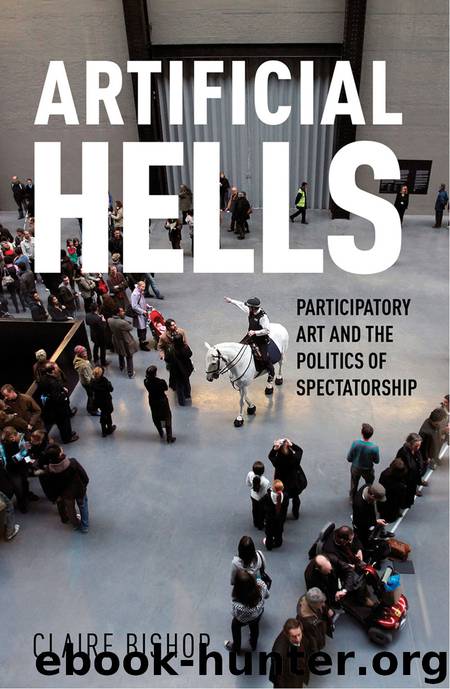Artificial Hells by Claire Bishop

Author:Claire Bishop
Language: eng
Format: epub
Publisher: Verso Books
Published: 2012-06-28T04:00:00+00:00
7
Former West:
Art as Project in the Early 1990s
In the preceding chapters I have mapped out the history of significant attempts to rethink the role of the artist and the work of art in relationship to society in various forms of participatory art from Europe, Russia and South America. Significantly, these have clustered around two moments of revolutionary upheaval: 1917 (in which artistic production was brought into line with Bolshevik collectivism), and 1968 (in which artistic production lent its weight to a critique of authority, oppression and alienation). The third moment, I would like to posit, is 1989.1 As might be anticipated, this has a less direct relation to artistic production than the previous two flashpoints, which were characterised respectively by top-down restructuring in the wake of revolution and by a momentum of more or less co-ordinated challenges to authority that were gradually internalised as institutional reform. By contrast, 1989 marks the fall of really existing socialism, a collapse that in the early 1990s was initially celebrated as the end of a repressive regime and then gradually, by the end of the decade, mourned as the loss of a collective political horizon. In Western Europe, this melancholy was given impetus by the dismantling of the welfare state (whose preservation had hitherto provided an important balance to the state provisions of the Eastern bloc) and numerous other neoliberal reforms, particularly in education. In Eastern Europe, the introduction of free market capitalism in the first half of the 1990s was accompanied by an initial optimism that rapidly gave way to disillusionment when faced with the reality of privatisation and ‘primitive accumulation’; freedom from the regime had been delivered in only the form of expanded consumer freedom. Because of the slow burn characterising these changes, the impact of 1989 on artistic production is less rapid and less straightforward than the leftist triumph of 1917 and its heroic last moment of resistance in 1968.
What I would like to track in this chapter is the way in which a certain impulse of leftist thinking visibly migrated into Western European artistic production after the collapse of ‘grand narrative’ politics in 1989. One of the main ways this became manifest was in the rise of a particular term to describe art in the 1990s: the ‘project’. Although the term ‘project’ was used by conceptual artists in the late 1960s (most notably by the Amsterdam-based gallery Art and Project), it tends to denote a proposal for a work of art. A project in the sense I am identifying as crucial to art after 1989 aspires to replace the work of art as a finite object with an open-ended, post-studio, research-based, social process, extending over time and mutable in form.2 Since the 1990s, the project has become an umbrella term for many types of art: collective practice, self-organised activist groups, transdisciplinary research, participatory and socially engaged art, and experimental curating. By focusing on the last two of these tendencies, it is hoped that the trajectory mapped in this chapter will
Download
This site does not store any files on its server. We only index and link to content provided by other sites. Please contact the content providers to delete copyright contents if any and email us, we'll remove relevant links or contents immediately.
Kathy Andrews Collection by Kathy Andrews(11737)
Thirteen Reasons Why by Jay Asher(8800)
The Red Files by Lee Winter(3368)
How to Do Nothing by Jenny Odell(3235)
The Genius of Japanese Carpentry by Azby Brown(3228)
Stacked Decks by The Rotenberg Collection(2812)
Tattoo Art by Doralba Picerno(2600)
Champions of Illusion by Susana Martinez-Conde & Stephen Macknik(2416)
The Artist's Way Workbook by Cameron Julia(2196)
The Art of Doom by Bethesda(2108)
Calligraphy For Dummies by Jim Bennett(1993)
Creative Character Design by Bryan Tillman(1890)
Botanical Line Drawing by Peggy Dean(1812)
Wall and Piece by Banksy(1782)
The Art of Creative Watercolor by Danielle Donaldson(1777)
One Drawing A Day by Veronica Lawlor(1767)
Art Of Atari by Tim Lapetino(1752)
Pillars of Eternity Guidebook by Obsidian Entertainment(1628)
Happy Hand Lettering by Jen Wagner(1558)
